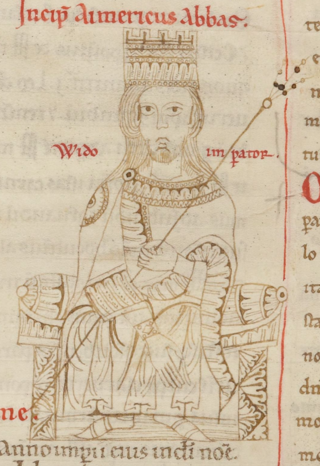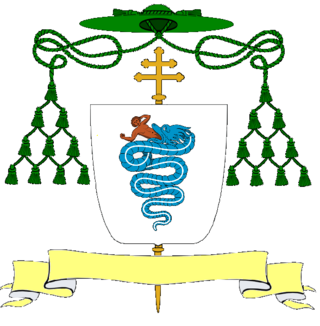Biography
Despite the tradition that he was a member of the Confalonieri family, this is not confirmed. When he was not yet a bishop, Anspert received by emperor Louis II the asset of Ansprand, who had killed the monarch's brother.
He was appointed archbishop of Milan on 26 June 868 and under Louis II he was missus dominicus . An educated man, he asked Irish monks to found the archbishop's scriptorium in Milan, a centre for the production of illuminated manuscripts. On 12 August 875, he moved to Brescia, where the emperor had just died, and organized his sepulture in the basilica of Sant'Ambrogio in Milan. In January of the following year, he participated in the coronation of Charles the Bald in Pavia, and received from the new king further territories at Cavenago, Vimercate and Ornago. In July 877 he took part in a council at Ravenna in which he obtained several privileges for the Milanese archbishopric.
After Charles the Bald's death (877), Anspert entered into conflict with Pope John VIII, who favoured Boso of Vienne as King of Italy, while the Milanese proposed Carloman of Bavaria. On 1 June 879 he was excommunicated and, in the following October, deposed; however, Anspert remained in charge as the Milanese clergymen supported him. Anspert and John reconciled when they met at the coronation of Charles the Fat as King of Italy (6 January 880) at Ravenna.
During his tenure as archbishop the church of Milan was named as Ambrosian
Anspert died in Milan in December 881 and was buried in the church of Sant'Ambrogio.

Boso was a Frankish nobleman of the Bosonid family who was related to the Carolingian dynasty and who rose to become King of Lower Burgundy and Provence.

Guy III of Spoleto was the Margrave of Camerino from 880 and then Duke of Spoleto and Camerino from 883. He was crowned King of Italy in 889 and emperor in 891. He died in 894 while fighting for control of the Italian Peninsula.
Guaimar I was the prince of Salerno from 880, when his father entered the monastery of Monte Cassino in August. His parents were Prince Guaifer and Landelaica, daughter of Lando I of Capua. From 877, he was associated with his father on the throne, a practice which had begun with the previous dynasty and continued until the end of Salernitan independence in 1078.

Filippo Archinto (1495–1558), born in Milan, was an Italian lawyer, papal bureaucrat, bishop, and diplomat. He served as Governor of Rome and then papal Vicar of Rome. He was personally esteemed both by the Emperor Charles V and by Pope Paul III. He was Bishop of Borgo San Sepolcro (1539–1546), Bishop of Saluzzo (1546–1556), and Archbishop of Milan (1556–1558).

Agnello Participazio was the tenth traditional and eighth (historical) doge of the Duchy of Venetia from 811 to 827. He was born to a rich merchant family from Heraclea and was one of the earliest settlers in the Rivoalto group of islands. His family had provided a number of tribuni militum of Rivoalto. He owned property near the Church of Santi Apostoli. A building in the nearby Campiello del Cason was the residence of the tribunes. Agnello was married to the dogaressa Elena.
Lambert I was the duke and margrave of Spoleto on two occasions, first from 859 to 871 and then from 876 to his death.
Guy II was the eldest son and successor of Lambert I as Duke of Spoleto and Margrave of Camerino. He was elected to succeed to these titles on his father's death in 880. He had an ambitious plan of expansion to the south and to the west that conflicted with the Papacy.
Jordan was the Archbishop of Milan from 1 January 1112 to his death on 4 October 1120. Born in Clivio, he entered the church of Milan young and was ordained a subdeacon while serving under the Archbishop Grossolano.
Anselm III was the archbishop of Milan from his consecration on 1 July 1086 to his death on 4 December 1093. He reestablished order in the Ambrosian see after more than a decade of fighting between the pataria and the religious authorities and confusion over the succession to the bishopric.
Arnulf III was the Archbishop of Milan from his election on 6 December 1093 to his death in 1097. He succeeded Anselm III only two days after his death. Along with Anselm III and Anselm IV, he was one of a trio of successive archbishops of Milan to side with the pope against the emperor in the late 11th and early 12th century.
Anselmo della Pusterla was the Archbishop of Milan, as Anselm V, from 30 June 1126 to his deposition early in 1135. He died on 14 August 1136.
This page is a list of Catholic bishops and archbishops of Ravenna and, from 1947 of the Archdiocese of Ravenna and Cervia, which in 1985 became styled the Archdiocese of Ravenna-Cervia. The earlier bishops were frequently tied to the Exarchate of Ravenna.
Angilbert II was the Archbishop of Milan from 27 or 28 June 824 to his death on the 13 December 859. He succeeded Angilbert I.

Federico Agnelli (1626–1702) was an Italian intaglio printer, engraver and typographer, active in Milan. He was chiefly employed in portraits, though he occasionally engraved emblematical and architectural subjects. He engraved with the architect Carlo Butio a set of plates representing the Cathedral at Milan.
Frederick was the Archbishop of Ravenna briefly from 1002 to 1004.

Luigi Giuseppe Nazari di Calabiana was an Italian churchman and politician: a senator of the Kingdom of Sardinia and Archbishop of Milan.

Roberto Visconti was an Italian Roman Catholic archbishop.
Alric, also known as Alrico, Adalric, and Odelric, was a medieval Lombard bishop of Asti in Italy from 1007 or 1008 until his death.
Enrico da Settala, sometimes anglicized Henry of Settala, was the archbishop of Milan from 1213 until his death.
Arnulf I, known as Arnulf of Arzago, was the archbishop of Milan from 970 to 974.
This page is based on this
Wikipedia article Text is available under the
CC BY-SA 4.0 license; additional terms may apply.
Images, videos and audio are available under their respective licenses.






